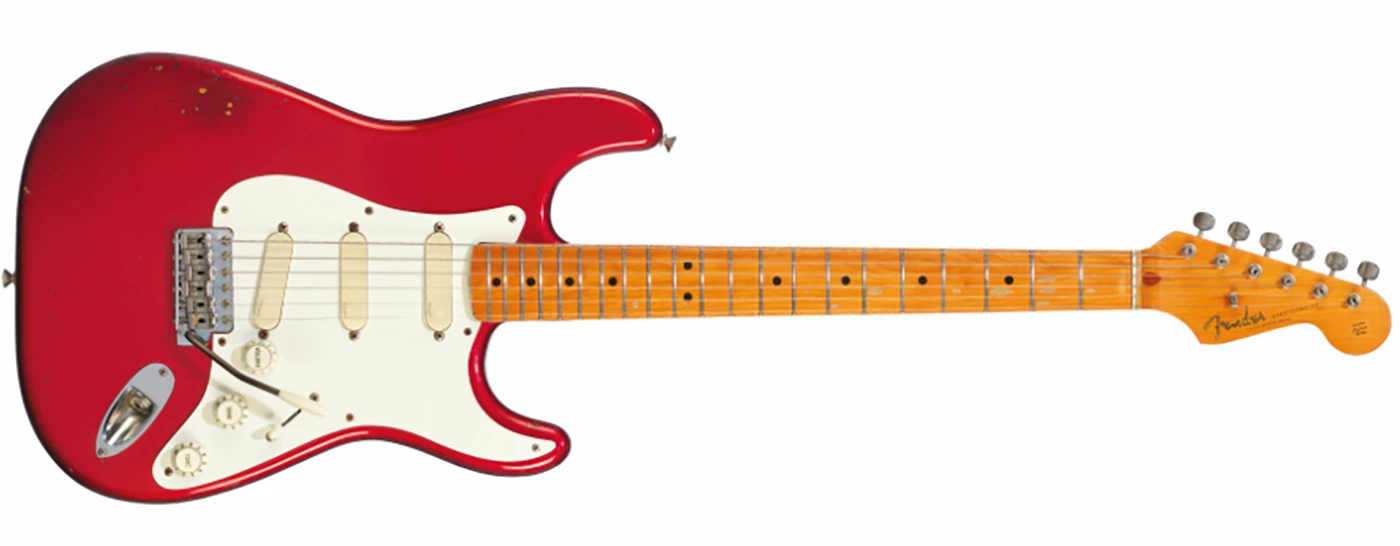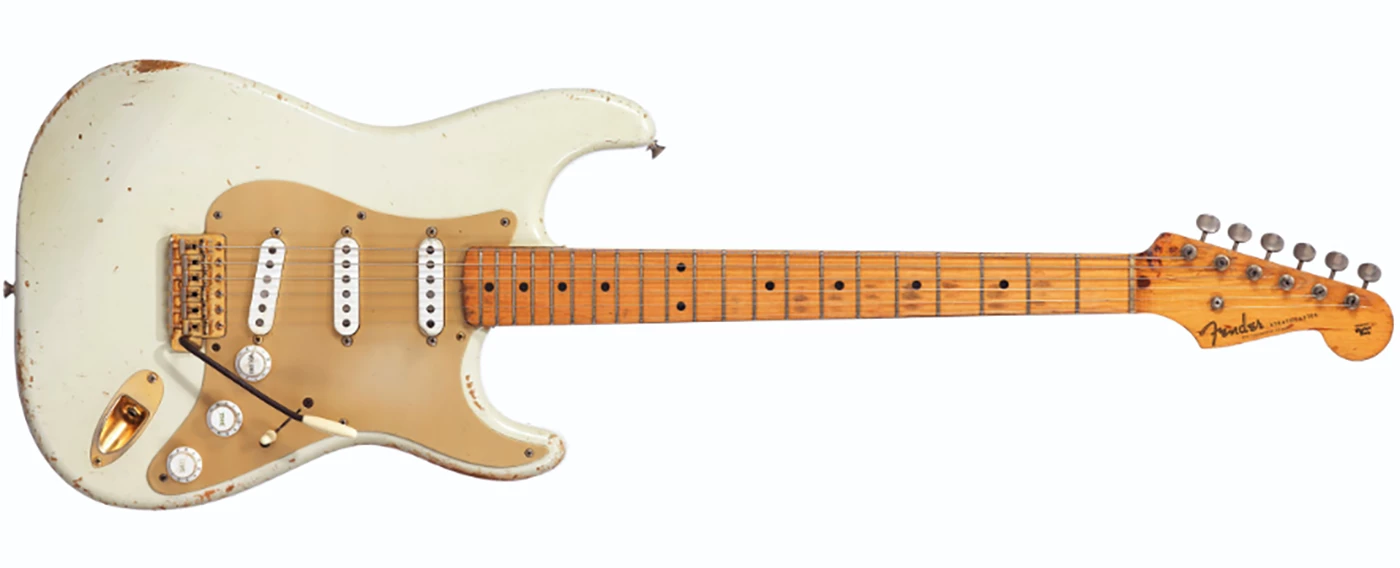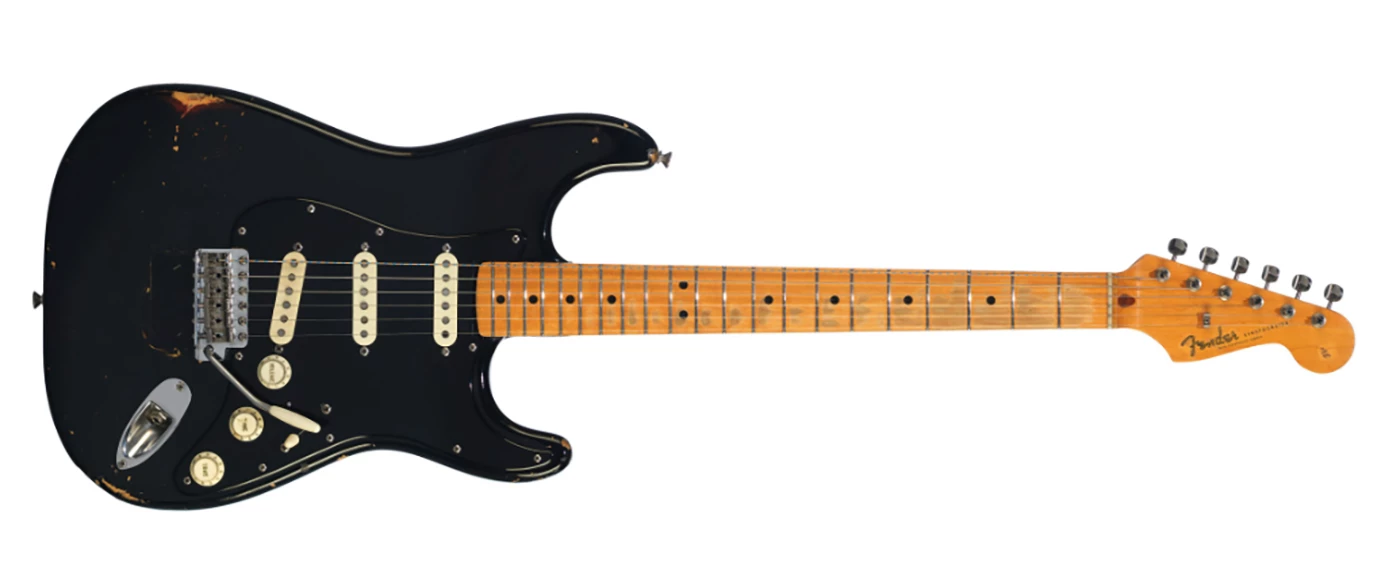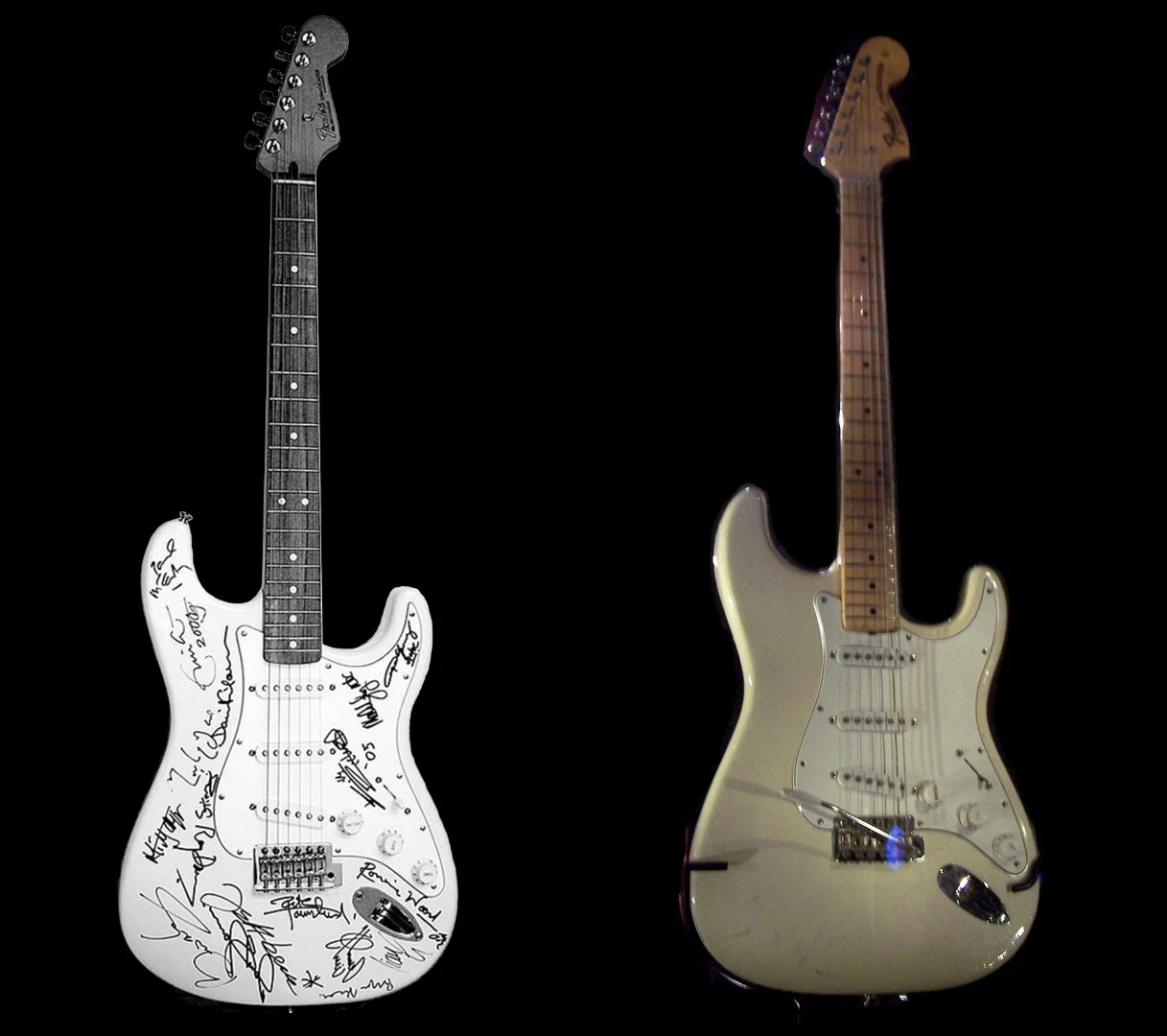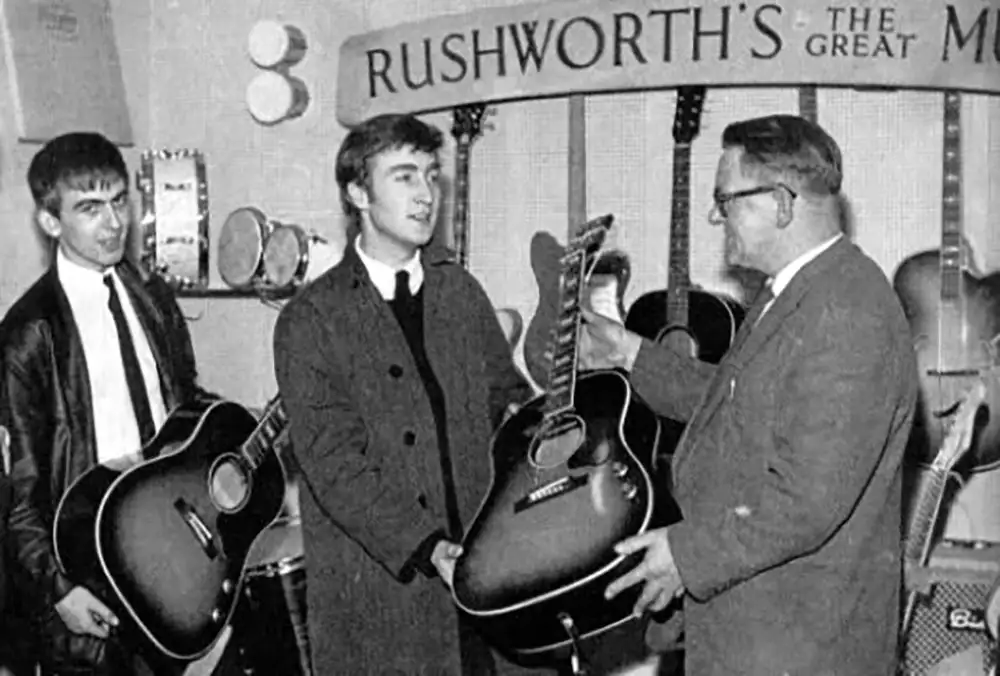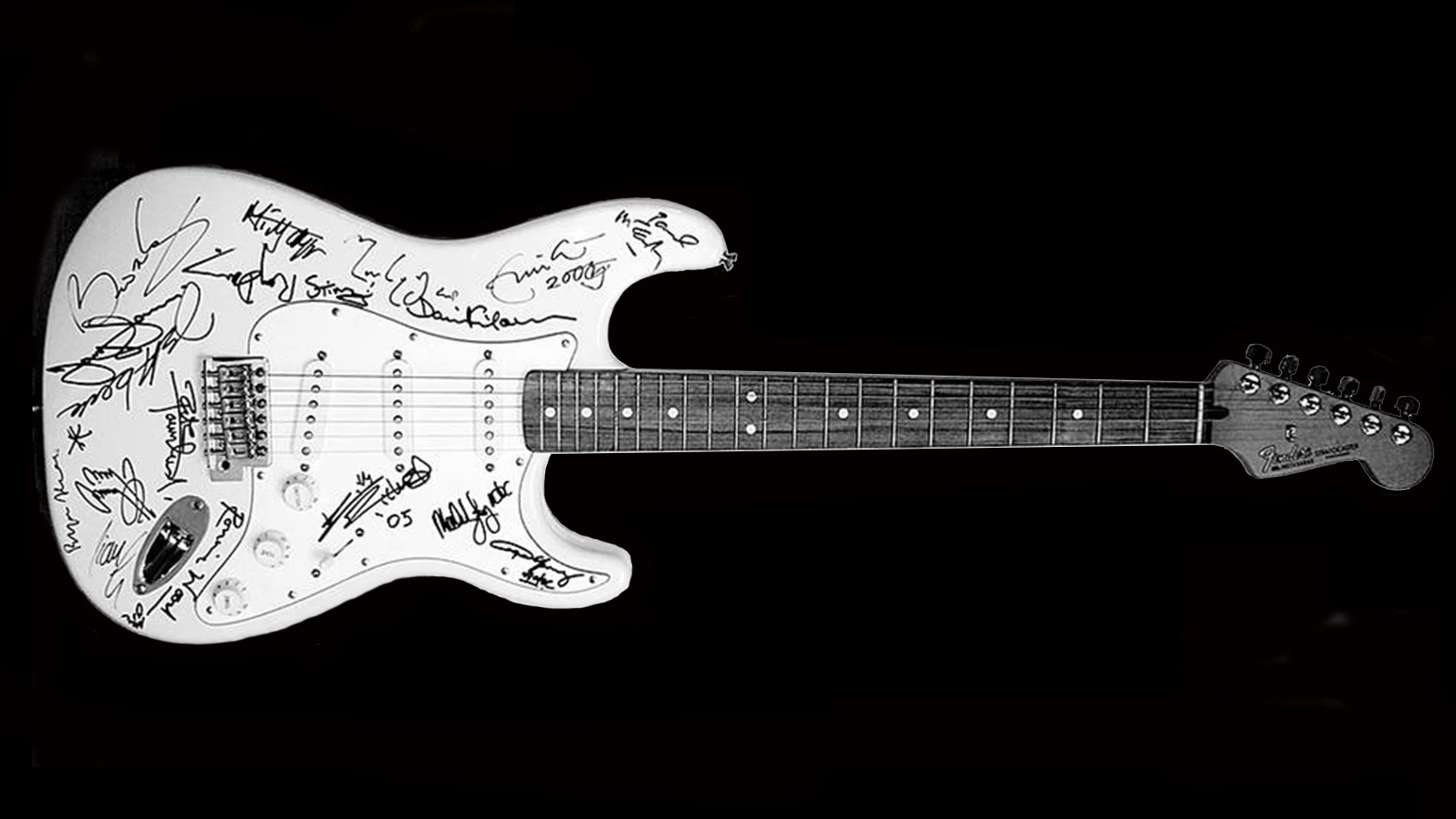Popular music has been ubiquitous since before any of NewAtlas' readers were born, and those who have created the soundtrack of our lives, have been anointed modern gods by their millions of followers.
Clapton, Cobain, Dylan, Harrison, Hendrix, Jagger, Jackson, Lennon, McCartney, Page, Richards, Van Halen ... we all know at least something they sang, played or wrote. For some of us, it might be one or two tracks for each artist, but for many of us, with whom an artist resonated, their entire creative output.
Global wealth management practices have recently come to regard the purchase of culturally significant objects as a sound financial investment, and the tools of the trade of the guitar gods have risen in value at auction quite dramatically in recent years.
A few days ago, David Gilmour, one of most revered guitar players in history, auctioned his entire 125-guitar collection, donating the money to a cause he is passionate about – fighting global warming.
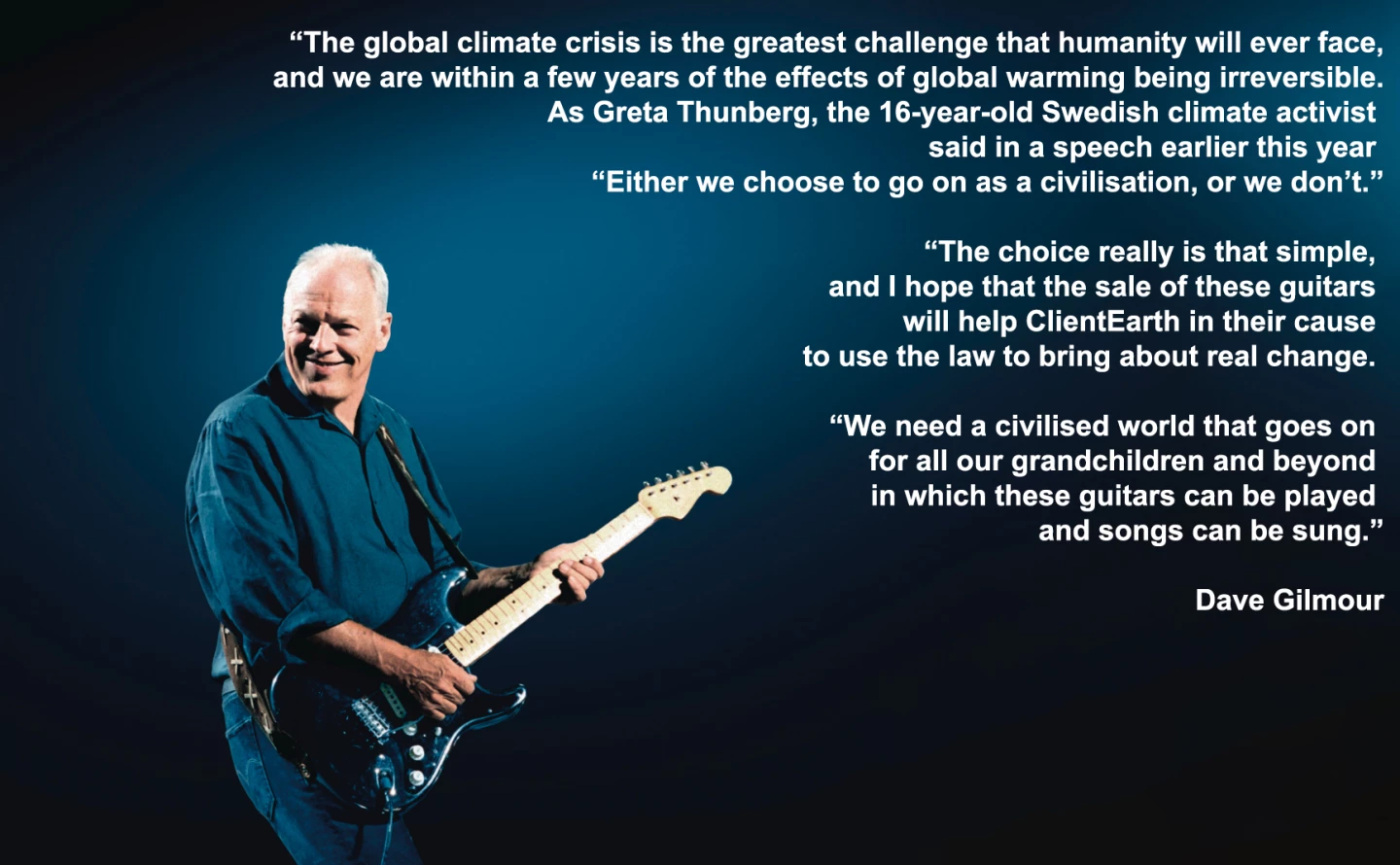
Pink Floyd was always a socially aware group of individuals, and provided many scathing anti-establishment anthems. Despite being one of the most commercially successful musical artists of all-time, Gilmour has always put his principals first. A 1995 interview with Guitar & Bass magazine is worth reading in testimony to his integrity. While many financially successful entertainers and sporting millionaires moved away from the United Kingdom and into tax exile, Gilmour preferred to raise a family in his native England, and famously said, "I'm not keener on paying tax than anyone else, but my freedom's not for sale."
The success of the auction is in no small way attributable to Christie's which has done an admirable job of displaying the collection to the widest possible audience by creating a virtual tour of the collection in exhibition form and highlighting the significance of each of the 125 guitars from Gilmour's collection.
In total, 58 of Gilmour's guitars sold for $100,000 or more, and 20 of those guitars are now among the most valuable guitars to have ever sold at auction.
If you are a Dave Gilmour/Pink Floyd fan, Christie's body of work on documenting the collection is immense and beautiful and fascinating and worth a look.
The jewel of the auction was Gilmour's "Black Strat" which sold for US$3.975 million, becoming the most valuable guitar ever sold, privately or at auction.
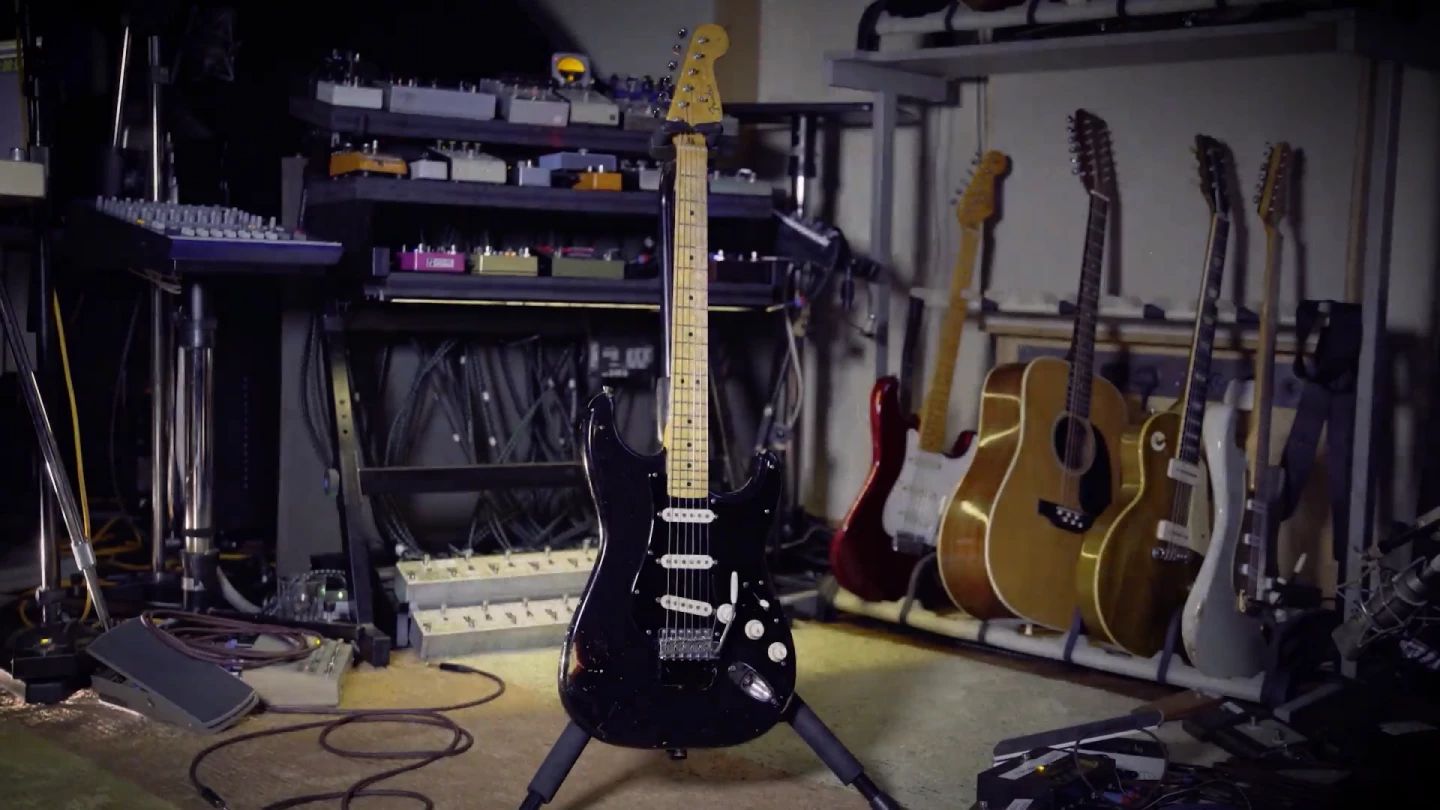
The Black Strat was Gilmour's primary performance and recording guitar on every Pink Floyd album from 1970 to 1983 plus all four of his solo albums. It is the primary guitar used on The Dark Side of the Moon (1973), Wish You Were Here (1975), Animals (1977) and The Wall (1979). It was also the guitar played in the famous Gilmour guitar solos in Shine on You Crazy Diamond and Comfortably Numb.
This is the feature guitar on two landmark albums – the The Dark Side of the Moon is the third most successful album of all-time and The Wall is the second most successful double album in history. This guitar has been heard by billions of people for half a century.

The previous record was $2.7 million, fetched by the "Reach Out to Asia" Fender Stratocaster auctioned for charity in 2005, and signed by Eric Clapton, Mick Jagger, Keith Richards, Brian May, Jimmy Page, Jeff Beck, Pete Townshend, Mark Knopfler, Ray Davies, Liam Gallagher, Ronnie Wood, Tony Iommi, Angus and Malcolm Young, Paul McCartney, Sting, Ritchie Blackmore, Bryan Adams and David Gilmour.
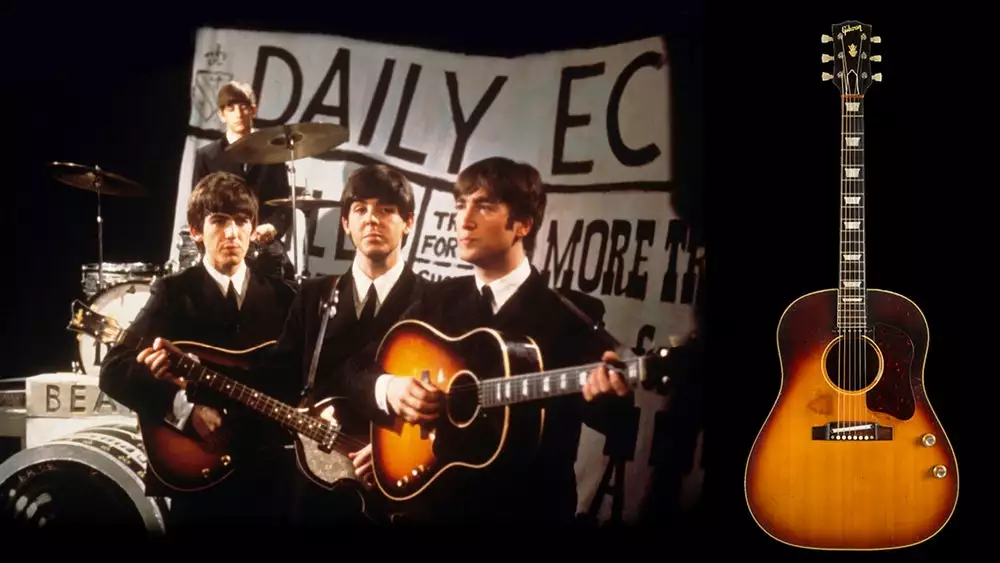
The third most valuable guitar sold at auction was John Lennon's $2.41 million Gibson J-160E which was used alongside Paul McCartney in writing and recording She Loves You, I Want to Hold Your Hand, Please, Please, Me and All My Loving.
Several other Gilmour guitars sold for stratospheric amounts in this latest auction, being a 1954 Fender Stratocaster with serial number #0001 ($1,815,000), an acoustic 1969 C.F. Martin D-35 ($1,095,000).
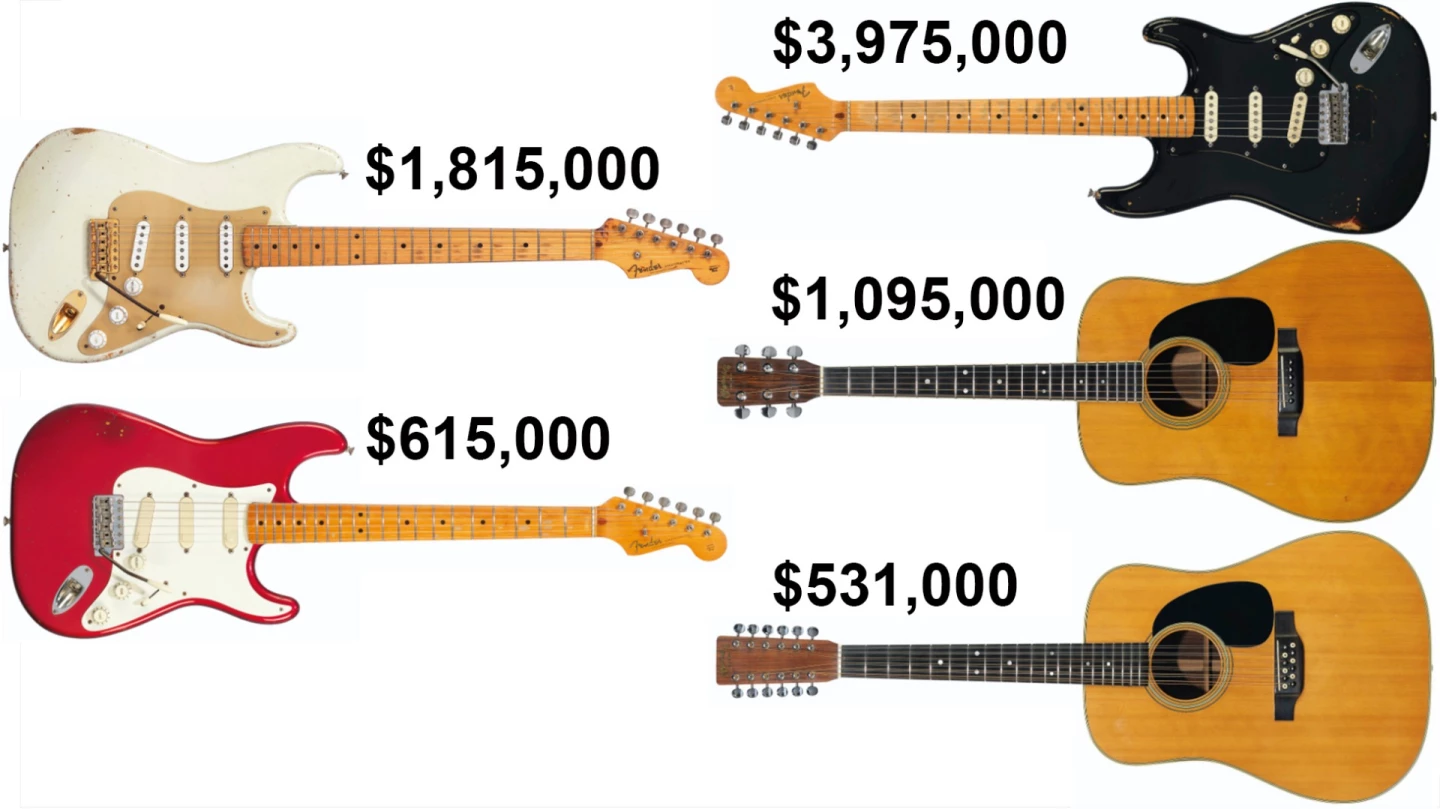
We've listed the major guitars sold by Christie's for David Gilmour below, with links to the Christie's auction pages. If any of them are of interest, make sure you read the "Lot Essay" on each guitar. The amount of information and anecdotes about each instrument is quite granular and fascinating.
$3,975,000 | "The Black Strat"

Estimate: $100,000 to $150,000 | Auction Description
$1,815,000 | 1954 Fender Stratocaster #0001
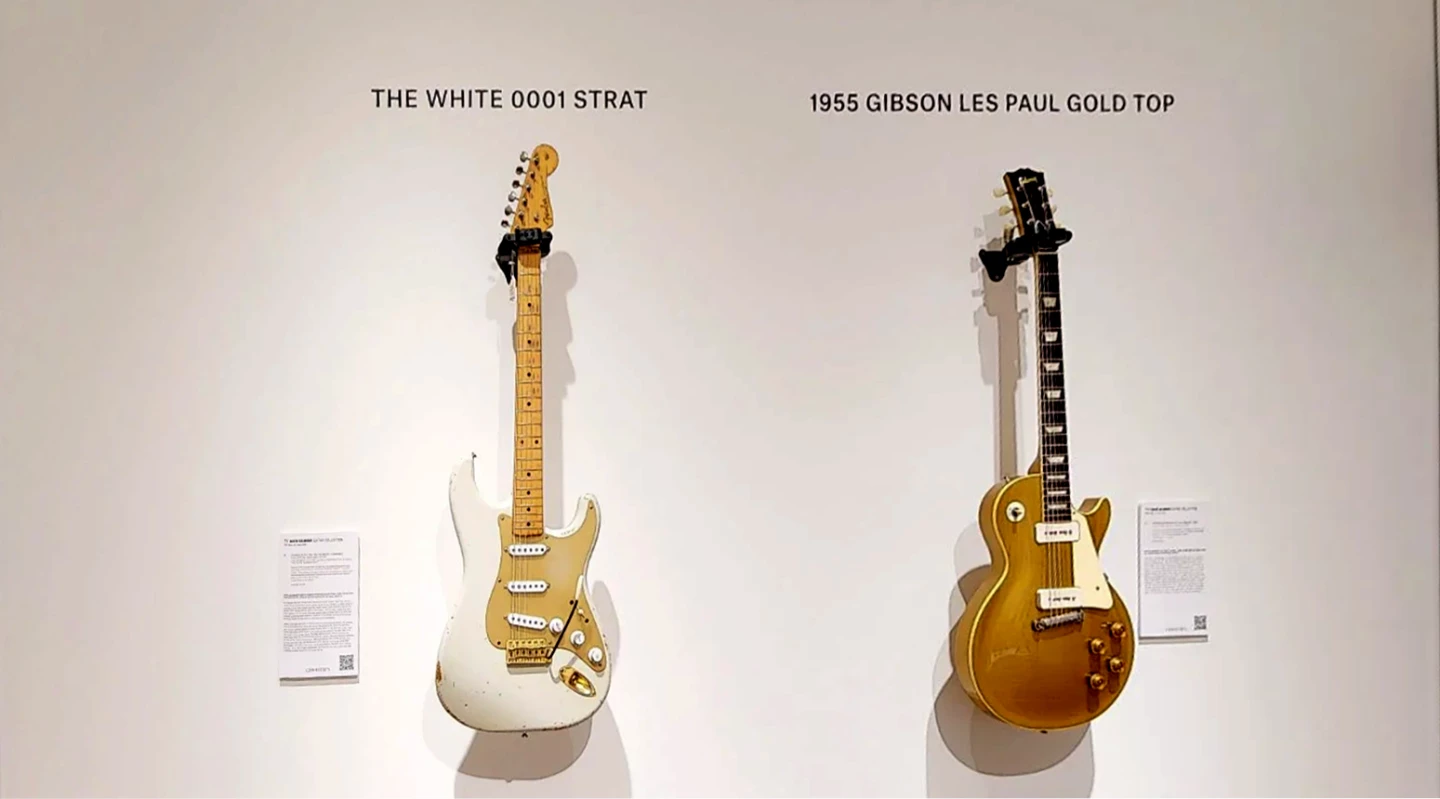
Estimate: $100,000 to $150,000 | Auction Description
It isn't the first Stratocaster. That had serial number #0100 and was last sold by Dave Gruhn of Gruhn Guitars in 2014 for $250,000, but with serial number #0001 and Dave Gilmour in its provenance, it isn't surprising that it fetched such an amount. The guitar was clearly built as a showcase piece with its white body, maple neck, three-way pick up selector and gold hardware. Gilmour purchased it from guitar technician Phil Taylor, who had bought it from Seymour Duncan. Gilmour used it to play Marooned, Coming Back to Life and Sorrow in the 2004 Strat Pack at Wembley Arena in honor of the Stratocaster's 50th anniversary.
$1,095,000 | 1969 C.F. Martin D-35
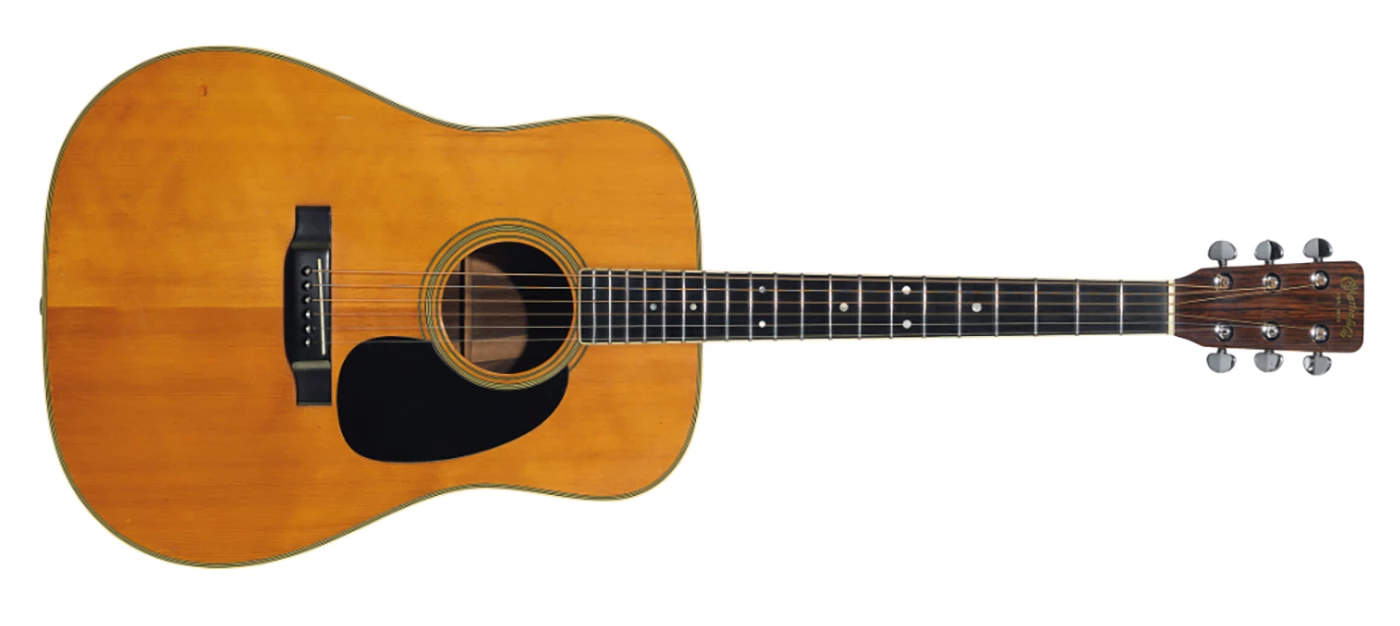
Estimate: $10,000 to $20,000 | Auction Description
This 1969 C.F. Martin D-35 was purchased from a musician was selling his guitar on the street outside Manny's Music in New York in 1971 and became Dave Gilmour's primary studio acoustic guitar since 1971. When asked by Sue Lawley on the BBC Radio 4 show Desert Island Discs what his luxury "desert island" item would be, Gilmour responded: Well to me it's not a luxury, it's an essential. I need to take my guitar with me, my acoustic Martin D-35 guitar, because life is impossible without a guitar.
When asked by Guitar Player magazine in 2003 which of his guitars had the most songs attached to it, Gilmour replied,"I guess it would be my Martin D-35. I used it on Wish You Were Here, and I've been using it ever since."
The D-35 can be heard on Welcome To The Machine, as well as the title track of Wish You Were Here, the tribute to former band member Syd Barrett. In The Story of Wish You Were Here, Gilmour reflected on his fondness for the song "because of its resonance and the emotional weight it carries, it is one of our best songs."
$615,000 | 1984 Fender Stratocaster 57V
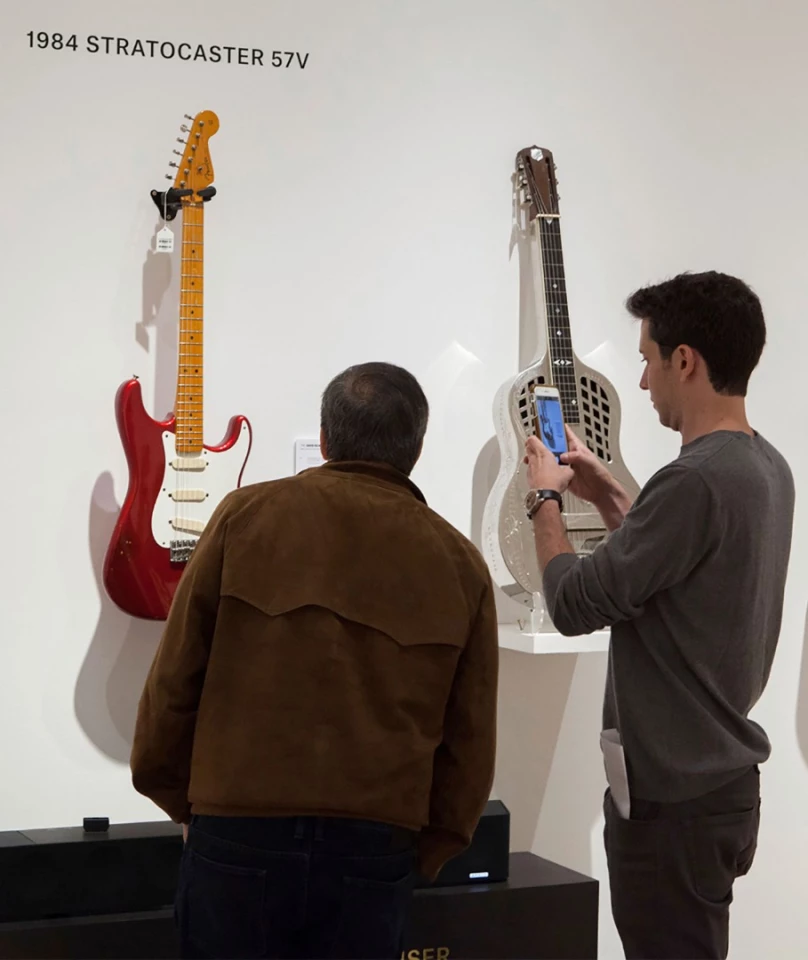
Estimate: $15,000 to $25,000 | Auction Description
Acquired in 1984, this Candy Apple Red 57V Stratocaster became Gilmour's primary studio recording and performance guitar from 1988 to 2005. In a 1985 interview with John Stix for Guitar for the Practicing Musician, Gilmour enthused, "the new Fender Vintage Series guitar I bought is probably as good as any Fender I own, old or new."
Gilmour played it on Paul McCartney's Give My Regards to Broad Street album and it was used for the guitar solo on No More Lonely Nights.
It made its first stage appearance at the Live Aid concert in 1985 when Gilmour's sunburst 57V Stratocaster (sold for $187,500 further down this list) failed during the first song of a set with Bryan Ferry on vocals, and Gilmour on guitar. He hot swapped to this guitar for the remainder of Sensation, then Boys and Girls, Slave to Love and a rendition of John Lennon's Jealous Guy.
$531,000 | 1971 C.F. Martin D12-35
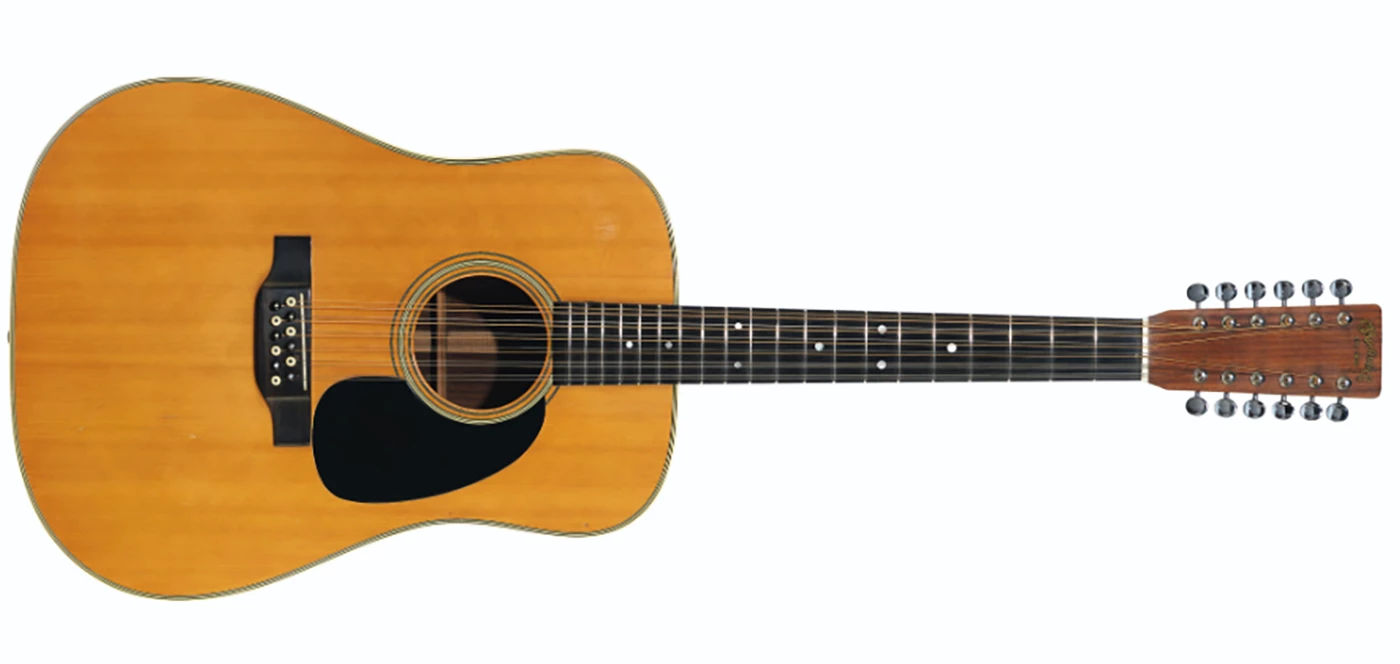
Estimate: $5,000 to $10,000 | Auction Description
From the auction description: ... this guitar has served as David Gilmour's chief 12-string studio acoustic for over forty years. Gilmour told us (Christie's):"It wasn't my first 12-string. I had a 12-string when I was a teenager and some of those instruments, you know, what happened to them is murky. I didn't have the funds to just buy another one, so they would often just be sold in order to buy something else, but I did have a 12-string. I always loved the 12-string, I used to listen to Lead Belly a lot, who was a great 12-string player, and there was another guy called Erik Darling who played a 12-string and I learnt some of his stuff. He was an American folk singing guy and he had an album that I was very, very fond of back in those days. He then joined, or formed, a little trio called the Rooftop Singers and had a big hit called Walk Right In, featuring a 12-string. So I always wanted to get another 12-string and I knew a guy who had a Martin 12-string and he wanted to get rid of it. I liked it, I bought it. It gave me Wish You Were Here, which was very generous of it."
Playing around with his new guitar at London's Abbey Road Studios during the making of Pink Floyd's 1975 album Wish You Were Here between January and July 1975, Gilmour hit upon the notes that would become the enduring title track to the album. When asked by Paul Rappaport in September 2011 how he made the music for Wish You Were Here, Gilmour explained:"I had recently bought a Martin 12 string from someone I knew and I was strumming it in the control room at No.3 at Abbey Road and that just started coming out, that riff …I started mildly obsessing with this riff that was slowly developing and, again, people's ears – Roger's [Waters] ears – pricked up."
Reflecting on the final recording, Gilmour continued, "every time I listen to the actual original recording I think God I should have really done that a little bit better, but the idea was that it was like a guitar playing on the radio and someone in their room at home …listening to it and joining in, so the other guitar was kind of supposed to be a kid at home joining in with the guitar he's listening to on the radio, and therefore it wasn't supposed to be too slick… and it wasn't."
$495,000 | ex-Homer Haynes 1957 Fender Stratocaster

Estimate: $60,000 to $90,000 | Auction Description
According to George Gruhn of Gruhn Guitars, this guitar was custom-made for country and jazz guitarist Henry D. "Homer" Haynes. As well as working as a session musician, Haynes was half of a successful duo named Homer and Jethro. Following Haynes' death in 1971, the instrument found its way into the possession of the California guitar dealer Frank Lucido, who included the rare guitar in a Stratocaster exhibition where it received a "best in show" blue ribbon award. In September 1979, Lucido sold the instrument to Gilmour's guitar technician, Phil Taylor, who sold it to Gilmour in 1983. It was then used in the promotion Gilmour's 1984 solo album About Face, with a shot of Gilmour with the guitar featured in the official program for the tour.
$447,000 | 1955 Gibson Les Paul Custom
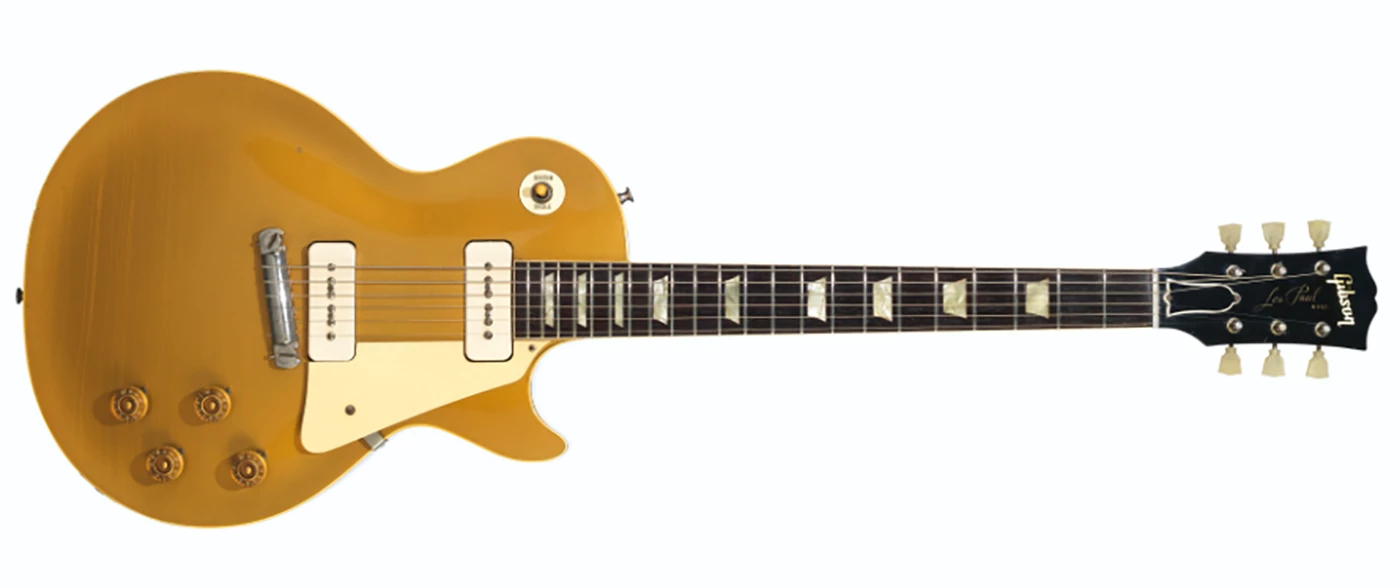
Estimate: $30,000 to $50,000 | Auction Description
David Gilmour purchased this 1955 "All Gold" Les Paul from Dave DeForrest at Guitar Trader, Red Bank, New Jersey in 1978. Gilmour used it for the famous guitar solo on Pink Floyd's hit single Another Brick in the Wall (Part 2) from their 1979 album The Wall which became Pink Floyd's first number one single in both the UK and US.
The guitar also contributed to the recording of Another Brick In The Wall (Part 3) and in the live shows in support of the album. Gilmour later used this Les Paul during recording of the song Round and Around on Pink Floyd's 1987 album A Momentary Lapse of Reason and for his solos on Poles Apart and A Great Day For Freedom on 1994's The Division Bell, with the solo in the latter almost two minutes long.
The guitar next appeared on stage at an evening of Beatles music at Cowdray Park in West Sussex on 21st June 2002 in aid of the White Lotus School, Ladakh and the Tibet House Fund. Gilmour played the first of his two sets on the Goldtop alongside Genesis' Mike Rutherford on bass and Bob Geldof on lead vocals for a medley of early Beatles numbers including I Wanna Hold Your Hand, She Loves You, Please Please Me, and Love Me Do.
Gilmour also used the 1955 Les Paul during the early recording sessions for what would become his 2006 solo album On An Island.
$447,000 | 1958 Gretsch White Penguin
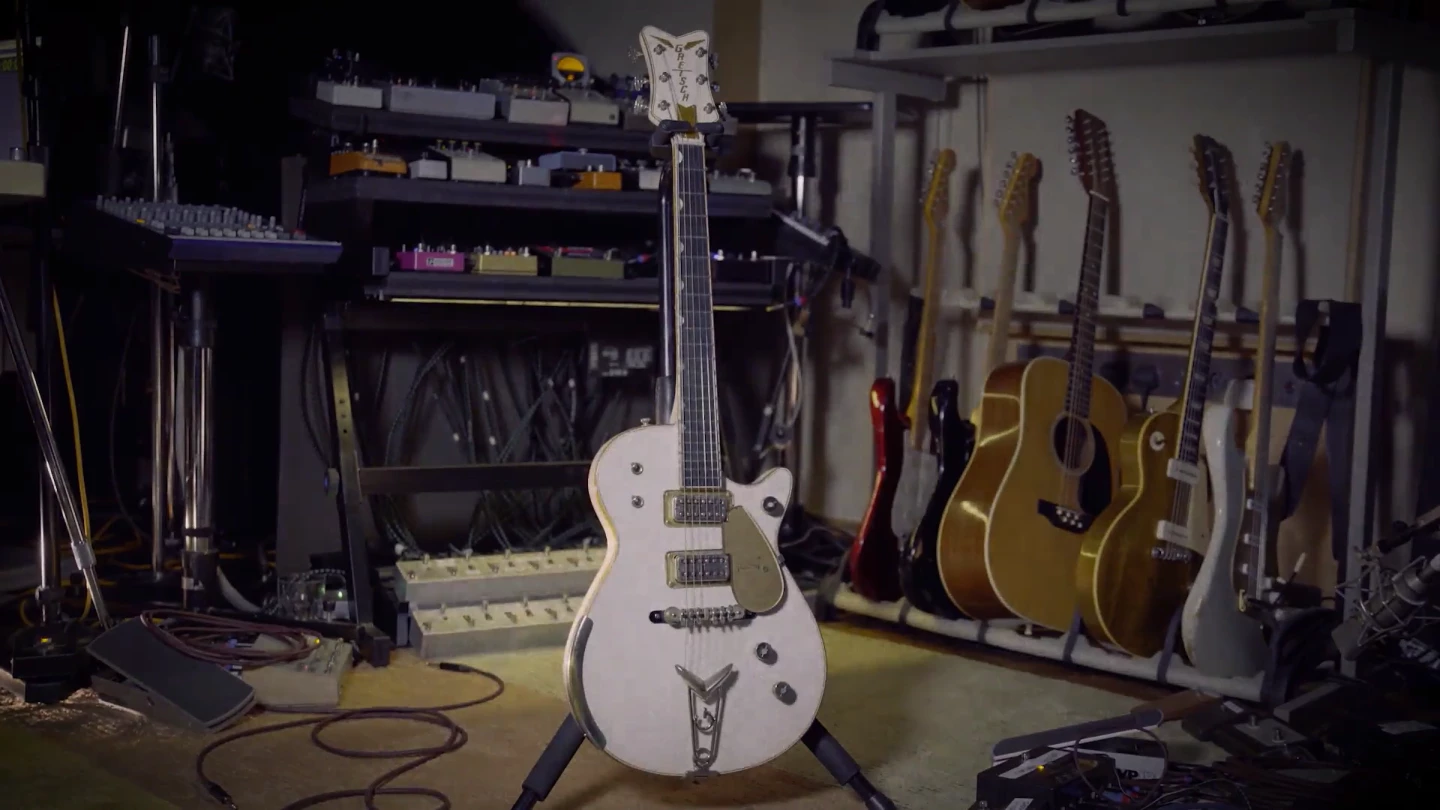
Estimate: $100,000 to $150,000 | Auction Description
The Gretsch White Penguin is a solid-body Falcon and one of the rarest and most collectible American vintage guitars with a total output of around 50 guitars. David Gilmour had wanted a Gretsch White Penguin for some time, and this guitar was purchased for Gilmour's collection in July 1980 and kept for home and studio use.
Gilmour told Christie's, "at some point I heard there was a sister or brother guitar to the White Falcon and set around to find one of those. It's a lovely instrument with something all of its own. These guitars can be so similar, same make, but they sing out in a different way. I've played it a lot, it's a lovely, lovely thing."
$423,000 | 1966 Fender Stratocaster
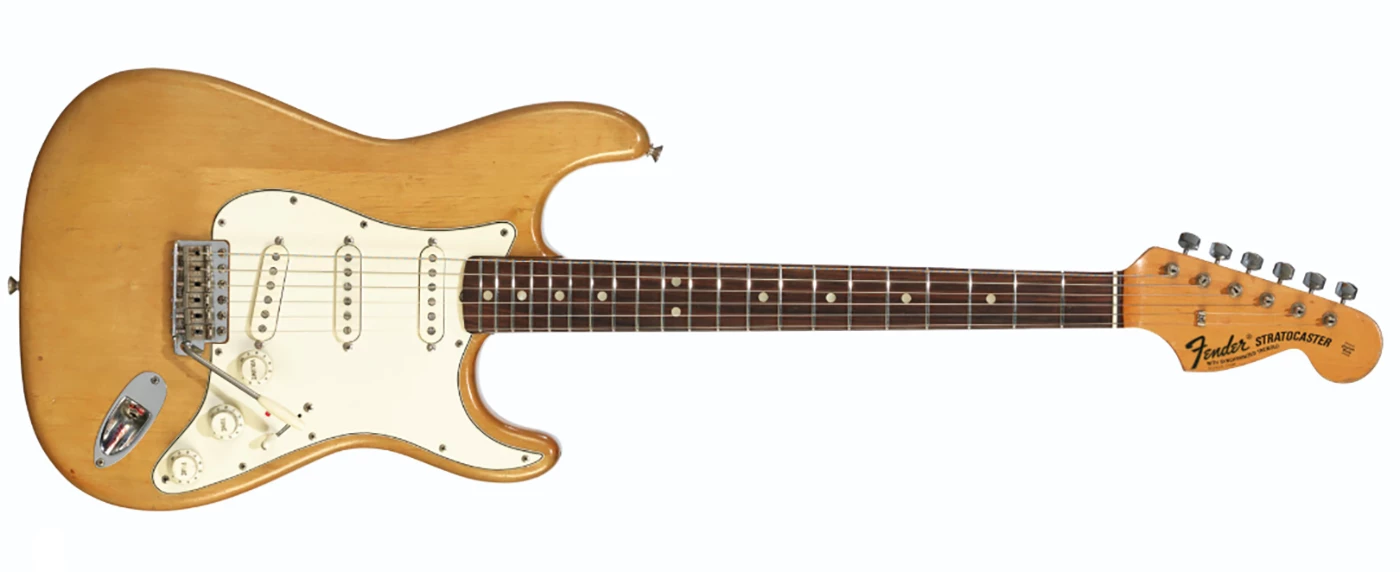
Estimate: $10,000 to $15,000 | Auction Description
Gilmour told Christie's,"I loved Fender Stratocasters, I loved Hank Marvin playing the Fender Stratocaster… The Stratocaster was my boyhood dream guitar and sometimes it's hard to wean yourself off that sort of thing."
Gilmour purchased this guitar in a second-hand shop in England in summer 1970. With a similar rosewood neck to his first white Strat, the guitar had been hand-painted in white over its original white finish. It was first used publicly at the Pop Deux Festival de St. Tropez in 1970. Gilmour can be seen playing the guitar in footage of both the sound check and full concert, recorded for French television show Pop Deux. Video of the event was included in the CD/DVD/Blu-ray package The Early Years 1970 Devi/ation, released in March 2017. It was also played to an audience of 500,000 at the Fête de L'Humanité, Bois de Vincennes in Paris, on September 12, 1970.
Gilmour personally stripped the guitar back to its natural wood finish at his flat on London's Old Brompton Road in the early 1970s, after which it was fitted with Dawson Stereophonic pickups in 1976 and kept for studio use. Gilmour particularly liked the sound of the middle pickup on this guitar.
$399,000 | 1976 Ovation Custom Legend
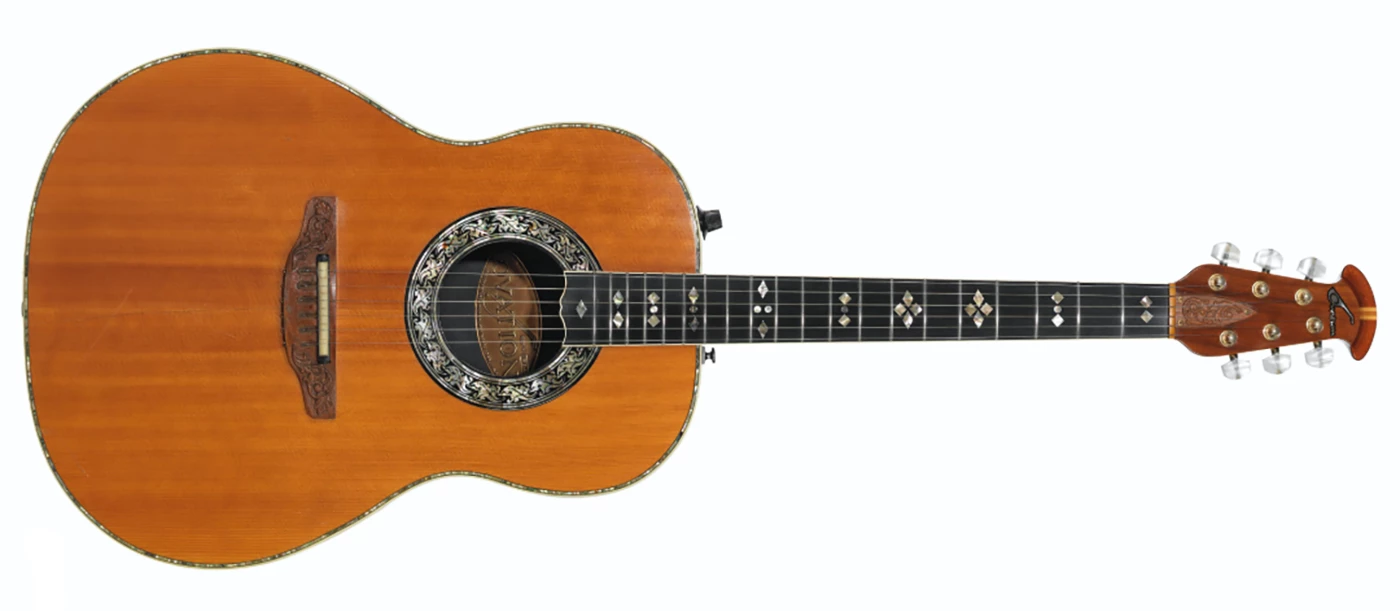
Estimate: $3,000 to $5,000 | Auction Description
Purchased from Ovation Instruments in 1976, this Custom Legend became one of David Gilmour's longest serving instruments, carried on every Pink Floyd and solo tour since and famously used to write and record the original demo that became Comfortably Numb. If you are a guitar nut, read Christie's lot essay on this guitar and you will be captivated.
$300,000 | 1974 Jedson electric steel guitar
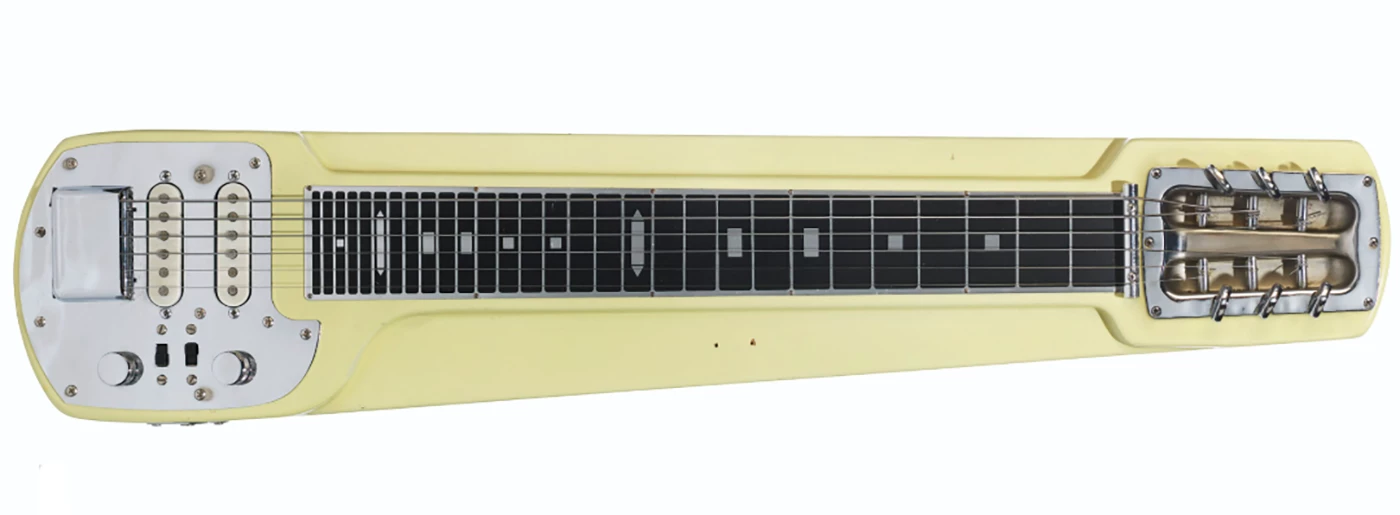
Estimate: $1,000 to $2,000 | Auction Description
Gilmour purchased a pair of Jedsons from Ivor Arbiter's Sound City in London in September, 1976, being this guitar and an otherwise identical red Jedson as a pair. They were both modified with Fender pick-ups swapped in and new electronics courtesy of luthier Roger Giffin, and the red Jedson became the performance guitar for The Great Gig In The Sky, while this guitar became the performance guitar for One Of These Days and Shine On You Crazy Diamond, tuned to an open G major - G, B, D, G, B, E.
Lots more interesting info on this particular guitar in the Lot Essay.
$275,000 | 1983/1989 Fender Stratocaster

Estimate: $8,000 to $12,000 | Auction Description
On January 31, 1984, David Gilmour was invited to the CBS Fender UK warehouse to trial Fender's new reissue line, and among those he selected was this guitar, serial number V015052. "I played through a lot of guitars and picked the best two," Gilmour recalled in an interview with International Musician in August 1984.
Preferring not to take his valuable vintage instruments on the road, this Vintage White 57V Stratocaster became Gilmour's guitar of choice, used as the main guitar on his About Face Tour from March 31 to July 16, 1984 in support of his second solo album About Face and features heavily in the tour documentary Pink Floyd's David Gilmour, released on VHS in September 1984.
Gilmour continued to use the guitar for live performances throughout the mid-1980s, including the first North American leg of Pink Floyd's A Momentary Lapse of Reason Tour, from September 9 to December 10, 1987. By the time the second leg kicked off in Australia and New Zealand in January 1988, Gilmour had begun to use the Candy Apple Red Strat exclusively. The Cream #1 was thereafter carried as a spare.
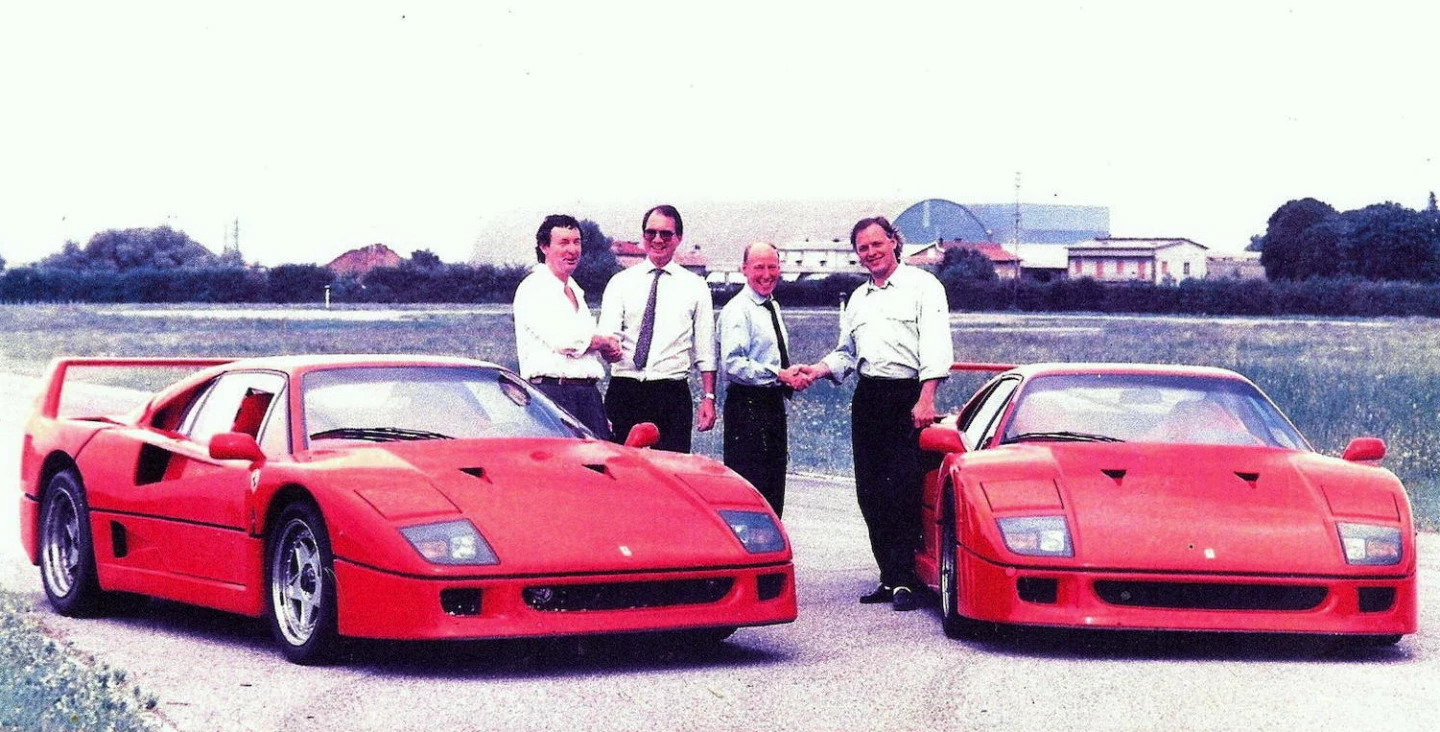
This Vintage White 57V was later used in the studio during recording of the soundtrack to La Carrera Panamericana, a 1992 retrospective documentary film on the history of the truly insane sports car race held in Mexico during the early 1950s. Gilmour and Pink Floyd drummer Nick Mason share a passion for cars (that's Mason at far left and Gilmour far right, picking up a pair of red Ferrari F40 Berlinettas at the Ferrari factory in Italy in July 1988), and produced the documentary together.
Both Gilmour and Mason drove in a reprise of the race, with Gilmour crashing at speed. While Gilmour was unharmed, his navigator (Pink Floyd's manager Steve O'Rourke) suffered a broken leg. Mason finished eighth in the race, and is one of the privileged few on Planet Earth to own a $50+ million Ferrari 250 GTO.
$250,000 | 1953 Gibson Les Paul
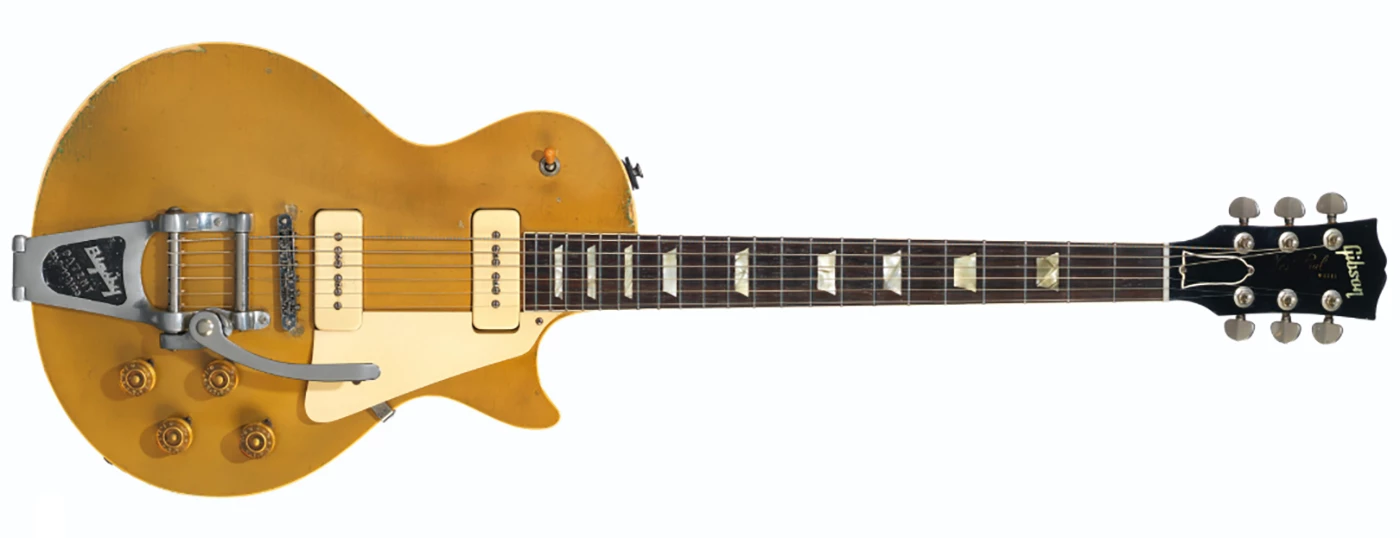
Estimate: $15,000 to $25,000 | Auction Description
From the auction essay: This guitar was purchased in London in early 2006 as a spare for David Gilmour's On an Island Tour, which ran from March to August, 2006. Gilmour later used the guitar during a recording session for Bryan Ferry's Olympia album and Gilmour can be seen playing this guitar in the documentary film The Making of Olympia, which was released with the Deluxe and Collector's editions of the album. The guitar was again enlisted as a spare for Gilmour's Rattle That Lock Tour from September 2015 to September 2016.
$243,750 | 1986 Gibson J-200 Celebrity
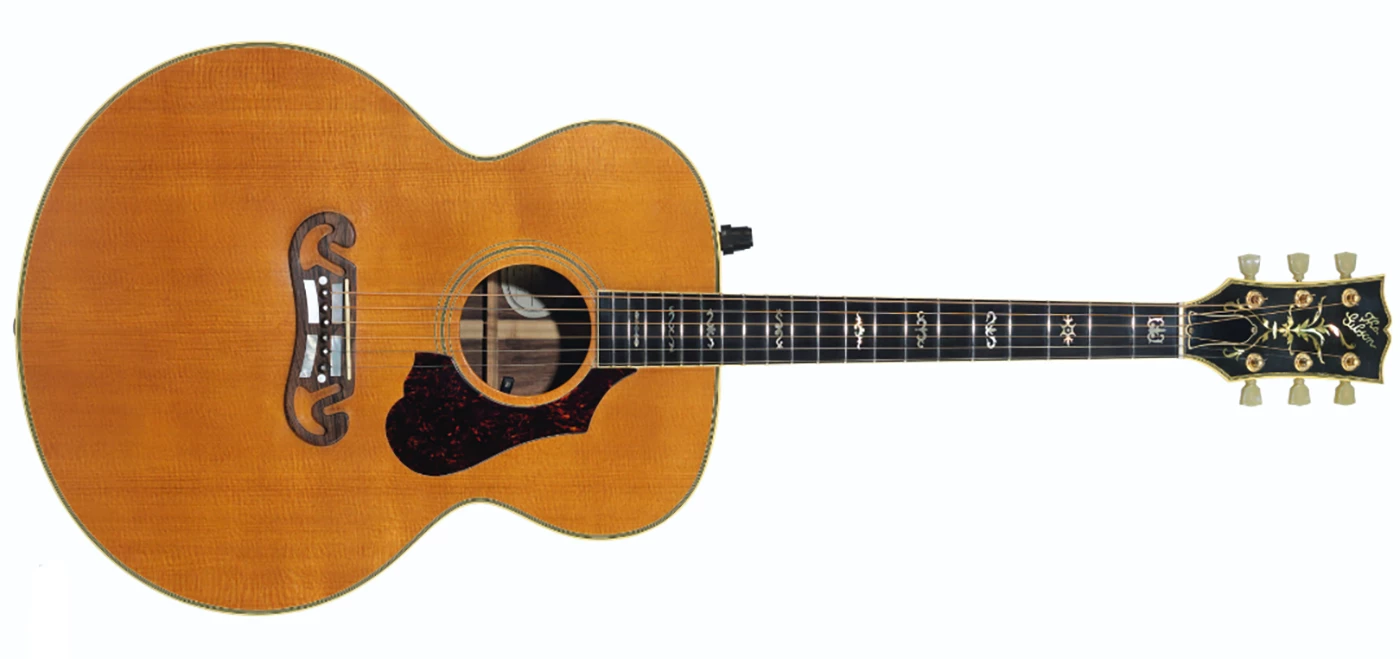
Estimate: $3,500 to $5,500 | Auction Description
The Gibson J-200 Celebrity was produced in a limited run of just 90 instruments to commemorate the 90th anniversary of the Gibson Company in 1985. After trying the J-200 Celebrity of Dire Straits bassist John Illsley, Gilmour contacted Gibson and this guitar was supplied directly by Gibson USA to David Gilmour in exchange for an endorsement agreement in November 1987. Gilmour liked the J-200 Celebrity so much that he set out to acquire a second example in 1994.
This J-200 Celebrity was used extensively during the recording sessions for Pink Floyd's 1994 album The Division Bell, and it was used extensively in the intervening years (see the lot essay for details) before its most significant public performance on July 2, 2005, when it was used in Wish You Were Here, broadcast live to an estimated 1.5 billion viewers across the world during the historic reunion of David Gilmour, Nick Mason, Richard Wright and Roger Waters in their classic-era Pink Floyd line up at Live 8 in London's Hyde Park on 2nd July 2005, their first performance together in 24 years.
$237,500 | 1985 Gibson J-200 Celebrity

Estimate: $3,500 to $5,500 | Auction Description
This guitar was originally owned by John Illsley of Dire Straits, and when David Gilmour played this guitar while recording in a neighboring studio to Dire Straits at London's AIR Studios in September 1986, (thought to be for Bryan Ferry's seventh solo album Bête Noire), the encounter resulted in Gilmour contacting Gibson and acquiring his own J-200 Celebrity (the lot directly above this one) in November 1987.
When a second J-200 was required for The 1994 Division Bell Tour, and Gilmour purchased John Illsley's guitar. Illsley had used the J-200 on stage for performances of So Far Away on Dire Straits' On Every Street Tour from August 1991 to October 1992 in support of their sixth and final album On Every Street. Tuned to DADGAD, Gilmour played this guitar throughout The Division Bell Tour for performances of Poles Apart. Gilmour explained the unusual tuning in an interview with Guitar World magazine in September 1994: …I thought it was something new that I had invented. One day, I was on holiday in Greece and I had an acoustic guitar with me. I just decided to tune the bottom string down to D and continued to experiment until I arrived at that tuning. Then I mucked around a bit and "Poles Apart" fell out of it a few minutes later.
$212,500 | 1984 Fender Stratocaster 57V
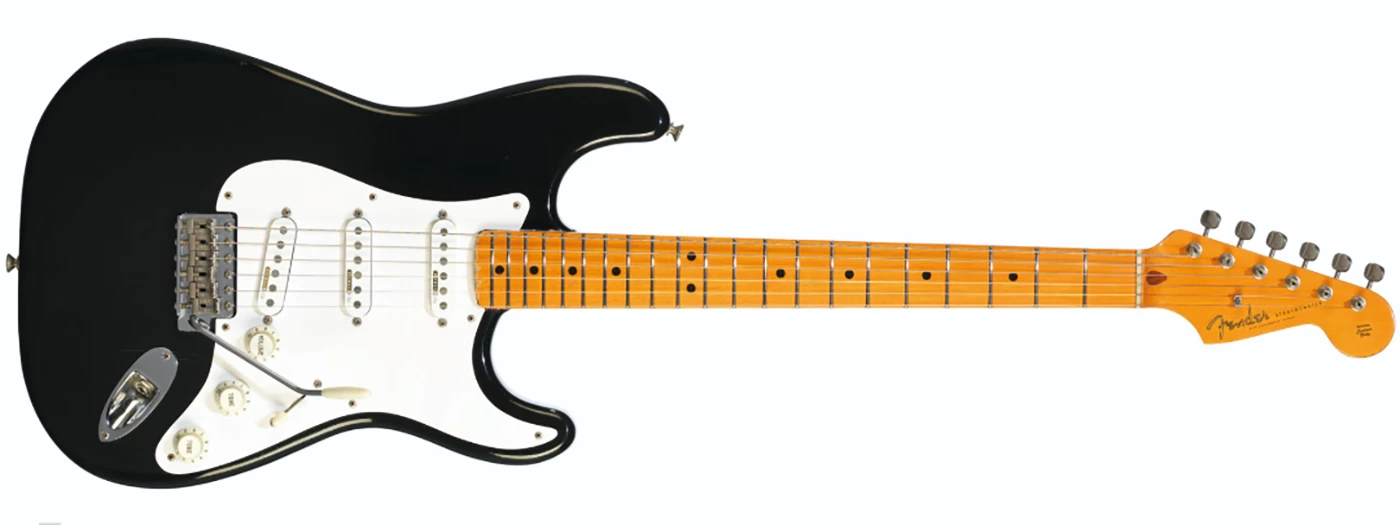
Estimate: $3,000 to $5,000 | Auction Description
David Gilmour acquired this guitar direct from Fender in early 1984 and kept it for home and studio use. It was played by George Harrison at Gilmour's Guy Fawkes Night fireworks party on November 5, 1988. It was then used on Pink Floyd's 1994 The Division Bell Tour by Tim Renwick. After being fitted with three Kinman Hx single coil pickups, the black 57V was used by album co-producer and Roxy Music guitarist Phil Manzanera during David Gilmour's On An Island Tour from March to August 2006. Manzanera again appeared with the 57V for a surprise performance by David Gilmour and his touring band at the DVD launch of Remember That Night at the Odeon Leicester Square in London on September 6, 2007. Eight years later, longtime Pink Floyd collaborator Jon Carin used this guitar while performing with David Gilmour during the first three legs of the Rattle That Lock Tourfrom September 2015 to April 2016, in support of Gilmour's fourth solo album Rattle That Lock.
$200,000 | 1959 Les Paul Custom
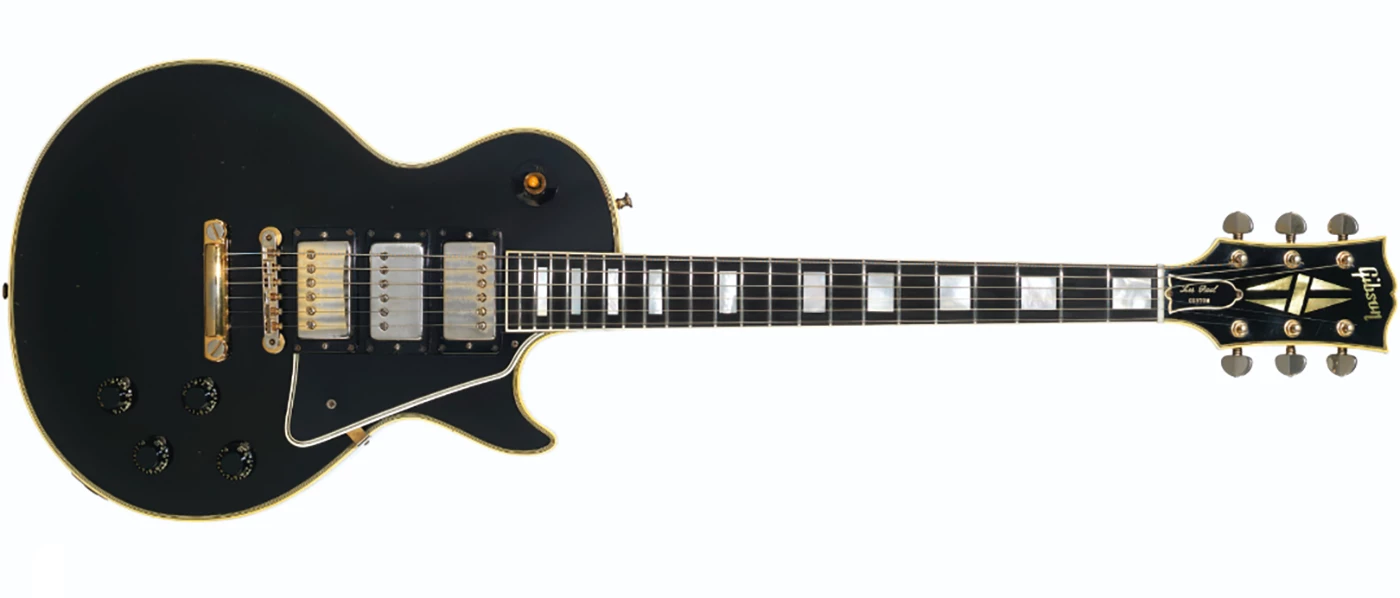
Estimate: $45,000 to $65,000 | Auction Description
David Gilmour purchased this guitar in December 1979 from Frank Lucido of California Guitar in Ventura, California, during a brief interlude between completing final recording and mixing sessions for The Wall at Producer's Workshop in Los Angeles in November 1979 and beginning rehearsals for the upcoming The Wall Tour in January 1980. Purchased to replace an identical guitar that had been stolen in 1976, Gilmour kept this guitar for studio use.
Gilmour told Christie's: A lot of the guitars, I have to say, I purchased because I saw someone using one and I thought "Oh I love that, I love the look of that," and I'm sure there was a Smokey Robinson and the Miracles 7in. cover which had him holding a black Gibson Les Paul with three pickups on it. Now this may be false memory, because memory gets a little unreliable these days, but that is my memory and I did want to get one of those, and in fact I did get one of those eventually. I think it got stolen, but I then did find another one which is the one we have now and is being sold.
$200,000 | 1950 Fender Broadcaster
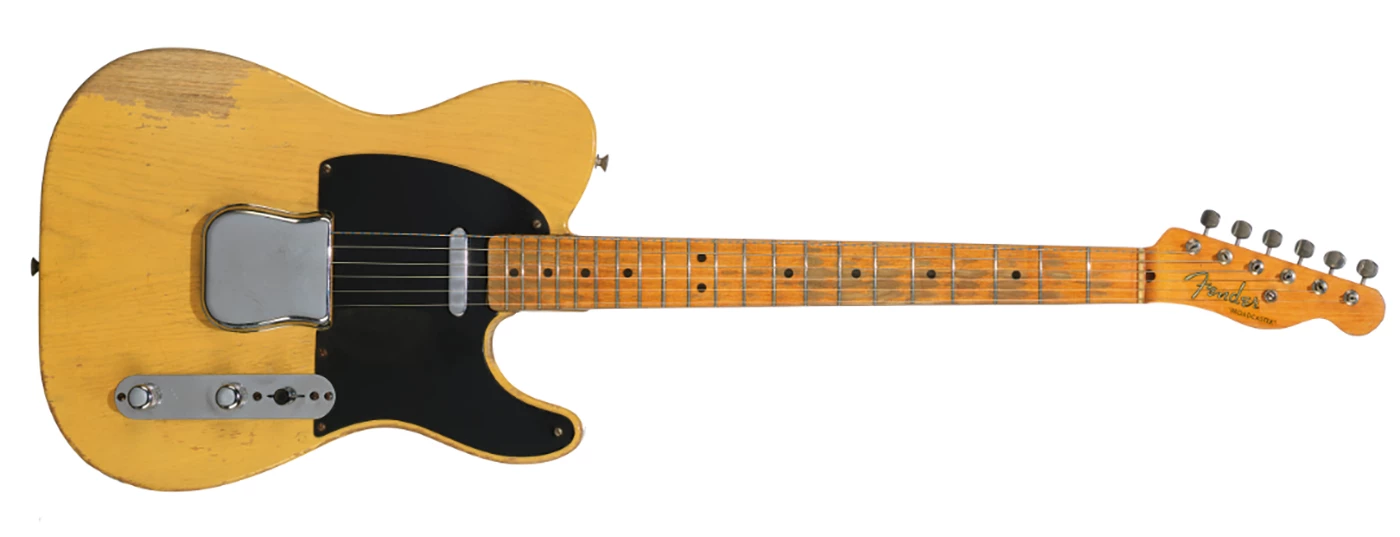
Estimate: $50,000 to $70,000 | Auction Description
Purchased in late 1979 by David Gilmour's longtime guitar technician Phil Taylor from Frank Lucido's California Guitar, Ventura, California, during the final recording and mixing sessions for Pink Floyd's 1979 album The Wall in Los Angeles, the guitar was subsequently sold to David Gilmour in 1983 and kept for studio use.
$187,500 | 1983/2004 Fender Stratocaster
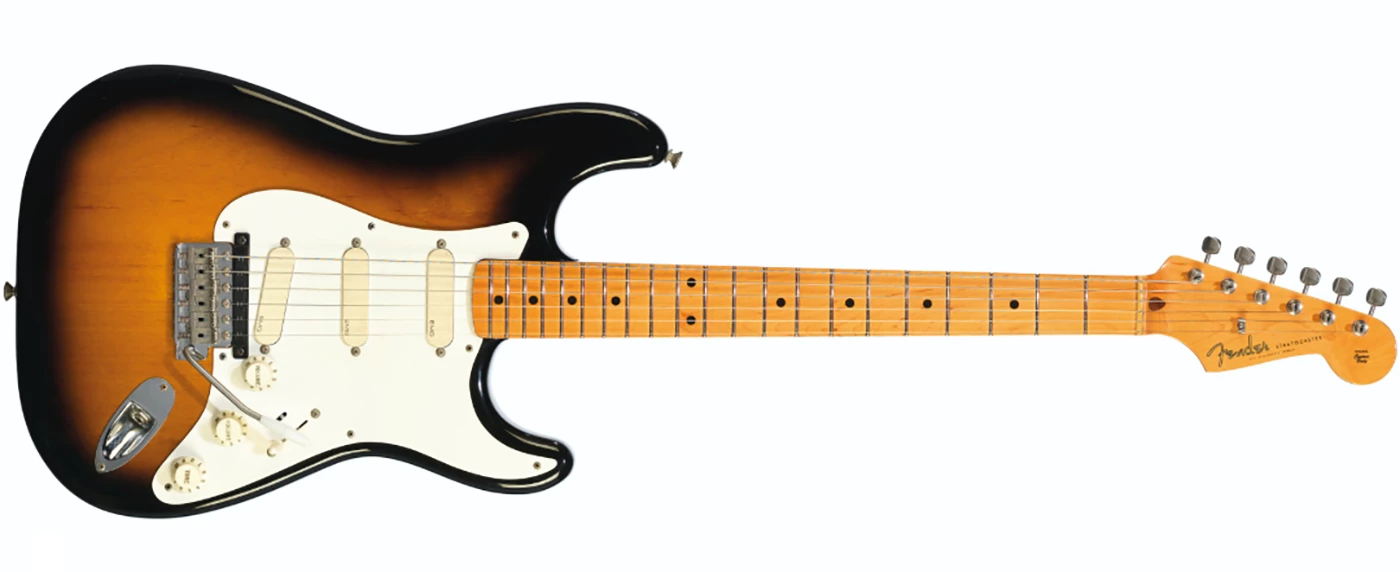
Estimate: $2,000 to $3,000 | Auction Description
Gilmour acquired this guitar in early 1984, and it was one of two 57V Fender Stratocasters that were modified for use with the 1984 Roland GR-700 guitar synthesizer and specially wired to facilitate Gilmour's performance requirements. Fitted with EMG SA pickups, Gilmour selected this guitar for a short set as part of Bryan Ferry's band at the Live Aid Concert in London's Wembley Stadium on July 13, 1985. The guitar's newly installed 5 way pickup selector switch failed a minute into the first song and Gilmour can be seen switching to his Candy Apple Red 57V (sold for $615,000 above) in live footage of the show.
$181,250 | 1988 Gibson Les Paul Custom
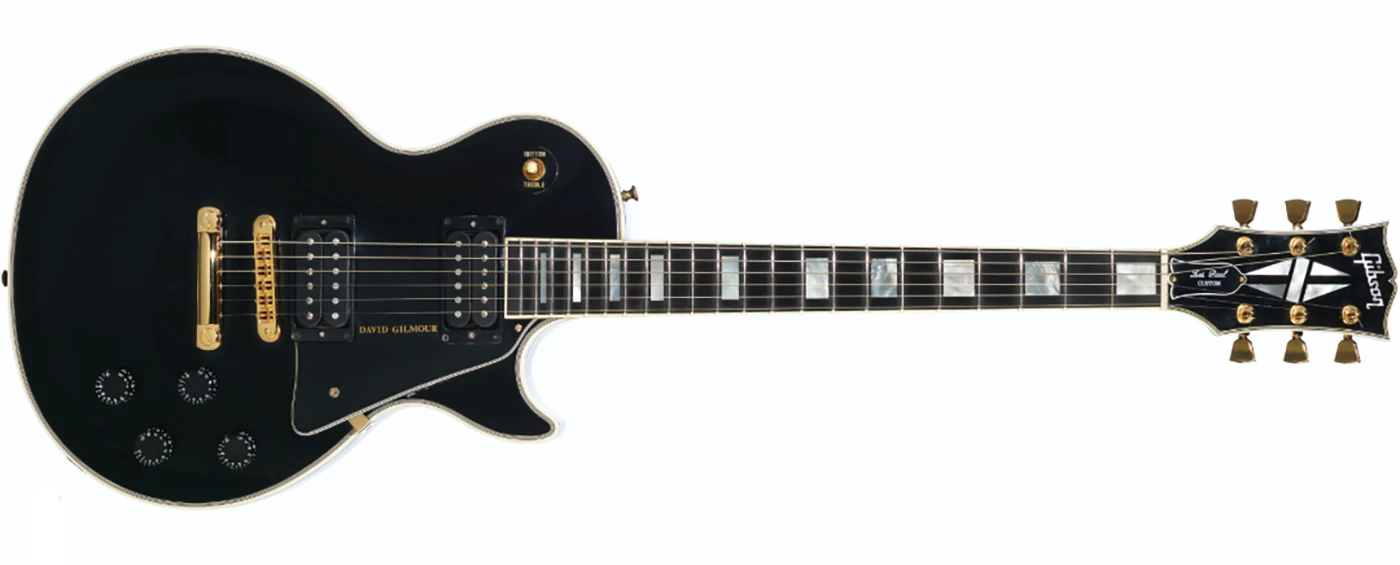
Estimate: $4,000 to $6,000 | Auction Description
This guitar was presented to David Gilmour by guitar legend Les Paul in appreciation of his guest performance at the Les Paul Tribute Concert at the Brooklyn Academy of Music, New York, on 18th August 1988, in between shows with Pink Floyd on the third North American leg of the A Momentary Lapse of Reason Tour. Gilmour performed a soulful blues solo, later returning to the stage for a guitar jam with a star-studded cast of musicians including Waylon Jennings, B.B. King, Steve Miller, Eddie Van Halen and Les Paul. Meeting B.B. King for the first time that evening, Gilmour recalls that after King heard him play, he approached him with the plaudit Hey, boy, are you sure you wasn't born in Mississippi? The full show was released on VHS in 1988 as Les Paul & Friends: He Changed the Music. Gilmour kept the guitar for studio use.
If you have read this far, you're no doubt a guitar enthusiast, so may we suggest our extensive feature, The 100 most valuable guitars ever sold at auction.







